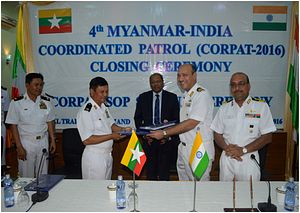This week, Myanmar’s deputy defense minister made a bit of a splash when he announced that the country’s military was considering purchasing submarines.
“Our neighbors have submarines and we want them as well…” Deputy Defense Minister Major General Myint New told reporters at a press conference according to The Irrawaddy, adding that the country’s military was considering acquiring the capability. “Submarines are necessary armed units for a navy.”
Myanmar’s intention to pursue submarines far from unique or new as the country builds up its naval capabilities. Four Southeast Asian states already have submarines: Indonesia, Malaysia, Singapore, and Vietnam. A few of Myanmar’s neighbors have also acquired submarines or are moving towards doing so – Bangladesh got the capability last year and Thailand is set to do so in the next few years, both with China as the source (See: “Did Thailand Secretly Approve Its China Submarine Buy?”). As I have noted before, the “keeping up with the Joneses” factor that partly drives Southeast Asian military modernization trends ought not to be discounted, even if at times it diverges from sound defense planning.
This is also far from the first time we have heard about Myanmar’s attempts to realize its submarine dream. Over the past decade or so, reports have periodically surfaced about either Naypyidaw’s desire to acquire the capability itself or the supporting technical capabilities such as submarine training, linking it with India, Pakistan, Russia, and even North Korea.
Yet intending to purchase submarines and actually buying them are two different things, and there is a lot that needs to be done to get from the first to the second. Most obviously, buying submarines is a costly affair, so the necessary funding needs to be available. The deputy defense minister pointed this out himself in his remarks, admitting that things “will depend on the state budget.” Though Myanmar’s defense budget over the past few years has remained at roughly between 13 to 14 percent of the total budget, submarines would have to be considered alongside other priorities within that budget due to the necessary tradeoffs that would have to be made (See: “What Does Myanmar’s New Defense Budget Mean?”).
There also needs to be the supporting equipment and technical capability to actually operate and maintain submarines, something which Myanmar’s military is aware of. That, too, will require more resources, not just in terms of money, but manpower and technology as well. To be fair, Naypyidaw has already moved to acquire some of this, including through study tours and courses. But much more is required.
So while we ought not to dismiss Myanmar’s consideration of submarines as a pipe dream, we also should not forget how heavy of a lift this actually is when we see the occasional headline floating around.
































